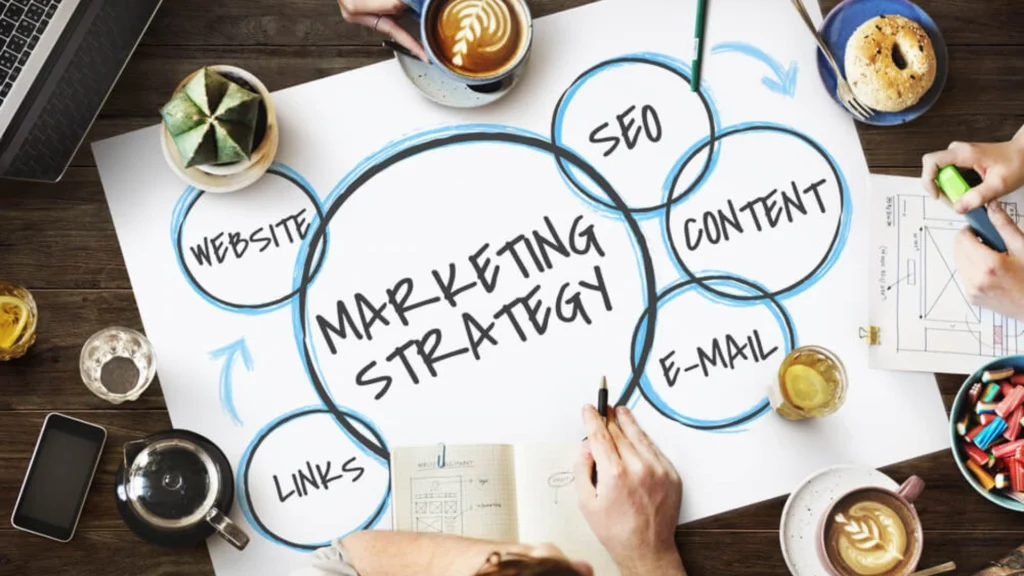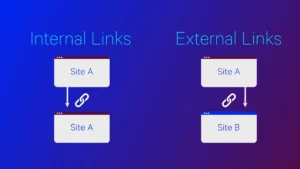This guide is for brands that need a simple yet effective marketing plan they can use right now. You will learn what a digital strategy is and how to set meaningful goals and build a meaningful content system.
We will also tell you how to manage your budget and track your performance. You will receive proven tools and the latest tips to make your plan successful and realistic.
What is a Digital Marketing Strategy?
This strategy involves a focused plan for reaching important business goals using online tools. It ensures that everything works together. You will first figure out your customers.
You will then choose the best platforms to reach them like social media or email. Then the final step is to decide on your content and budget. It means that all your efforts are aligned and moving toward the same goal instead of just being random tasks.
Why does it matter?
Here’s why a digital marketing strategy is a must for businesses:
- Business leaders need more ROI with less budget. So you must be cautious about where to spend money and ensure that every rupee brings results.
- Major brands prioritize social media and pay influencers well to promote their products. So your marketing plan must follow social trends to succeed.
- AI speeds up content and analysis but can’t create your strategy. You still need to decide on clear goals and a plan to convert customers yourself.
- Customers see online reviews and referrals to research brands before visiting your site. A strategy helps you earn their trust at every touchpoint.
What are the 7 Mandatory Questions?
Make sure the plan you create answers these core questions to ensure your digital success:
- Who is Your Audience?
You need to know about their specific job and what success looks like for them instead of using vague groups.
- What is Your Core Benefit?
Explain how your product fixes their problem or offers them a massive benefit in one line.
- Where and how do they commit?
Map the entire customer journey from considering a purchase to the aftermarket. Then identify every touchpoint where they evaluate your brand.
- What proves success?
Connect your goals to business revenue by tracking qualified leads and Lifetime Value.
- Which online channels are important?
Commit fully to fewer digital channels and ensure they work smoothly together.
- What content truly helps?
Create content specifically for the exact times when customers are searching and ready to make a choice.
- How will we track and improve?
Decide on your KPIs and how often you will test and change your plans. Also decide how you will get customer feedback.
RACE: Your Trusted Framework
You can use this model to structure your entire plan from start to finish.
Step 1: Plan
It’s the initial stage where you:
- Conduct research
- Set clear goals
- Decide on your budget
- Make rules
Step 2: Reach
It involves establishing market presence by using different platforms to get people to see your brand.
Step 3: Act
Motivate people to take the first step towards your brand like watching a video or signing up for a trial.
Step 4: Convert
It’s the stage where customers’ interest turns into actual sales and results for your business.
Step 5: Engage
Here we focus on
- Customer Retention
- Encourage repeat sales
- Turn them into loyal brand advocates.
Create Your Digital Marketing Strategy in 10 Simple Steps
This section provides some easy moves to create a holistic marketing plan. And below’s the complete process written in plain and clear language:
- Define Your Goals
Choose two or three precise business results you want to achieve such as a lower customer acquisition cost. Also make sure to write down any limits you have like your highest budget or the number of leads your sales team can manage.
- Understand Your Audience
You need to create a simple profile for each of your main customer types. Figure out their motivation to search and where they search online. Also learn the words they use to search online and what kinds of content will encourage them to buy.
- Map User Journey
Know the exact times when customers search or buy something online. Then you must decide which content or ads you will use to appear and be helpful in those specific moments.
- Set Marketing Goals
Set specific targets. Aim for top search rankings and a set number of quality visitors for organic traffic. Keep your customer acquisition cost low and get your investment back within six months for Paid ads. And focus on boosting conversion rates for the lifecycle.
- Pick Your Core Channels
You should focus on only three to five main channels and say no to everything else for now. Use paid search ads to target people ready to buy immediately. And use social ads to build genuine interest and retarget past clients.
- Build Your Content System
Your content system is divided into four main types including money pages, demand pages, authority pages, and retention content. Each type plays a critical role in moving customers through their journey from initial interest to lasting loyalty.
- Create conversion paths
You must map every step a customer takes from clicking an ad or search result right through to their first purchase and product onboarding. Your job is to make this path easy by ensuring your pages load fast and you only ask for the most essential information when they sign up or check out.
- Build Reporting Structure
You need to decide where your critical data will be stored. It’s crucial to track your customers’ entire journey from the first channel or ad they see to the revenue it generates. Track what customers do after buying to find chances for repeat sales or to turn them into loyal advocates.
- Budget and Pacing
You should allocate your budget based on your planning stage. Keep your spending aligned with what’s normal for your industry. The rule is simple as you just need to do fewer things but do them better.
- Adopt Continuous Testing
Review your performance each month and adjust the budget if needed to focus on what’s working best. Actively test new ideas like new offers and ad copies every two weeks. Review your strategy every three months to decide which activities to stop and which to start.
Specific Channel Strategies for 2025
This section will provide proven techniques focused on building authority and improving profits. Success relies on choosing trusted creators and optimizing conversion rates.
- Search (SEO+Paid Ads)
Become an expert on customer problems for organic SEO traffic. Group your website articles by logical topics and earn backlinks by sharing original data or studies. Target users who are ready to buy Paid Ads now. Use precise search terms and ensure the text in your ad matches the landing page content exactly.
- Social Media & Creators
Use online platforms as a regular testing ground for social media. Publish short videos and posts to test ideas. Then use your ad budget to promote successful ideas. Partner with influencers if trust is what you need to succeed. Their content is often more effective than your brand’s.
- Email and Customer Journey
You should group your customers based on their actions like what they like to read and how often they buy for email marketing. You can set up email series that are automatically sent when a customer takes a specific action. This includes things like a welcome series when they first sign up or a special offer to bring inactive users back.
- Website & CRO
Your website must be fast and simple. Make your USPs instantly clear. Give visitors specific calls to action and build trust by showing many customer reviews and case studies. Most importantly, you must test different offers to find the ones that attract customers most likely to become paying customers.
How to Determine Your Budget
Focus first on what drives sales by spending on high intent ads and improving your top sales pages. You can then try affordable growth strategies such as retargeting and key influencer partnerships.
Marketers use AI tools to make their work fast and easy. But they should always review the results themselves. Many marketers are using AI because it helps them achieve better results and saves them time.
Your 90-Day Action Plan
Its roadmap provides a framework for quickly building a strong marketing benchmark and launching core programs. This approach ensures resources are allocated directly to core activities rather than dispersed across unproven bets.
- Phase 1: Day 1 to 15
Dedicate your first two weeks completely to your foundation. Interview your customers and competitors and audit your analytics and CRM data. You will map out your journey and select your top three KPIs during this phase.
- Phase 2: Day 16 to 45
This is your building phase. You will publish your main sales pages and the three most popular content pieces. Launch basic paid search and retargeting ads. Your last step is to complete your tracking setup so you can align all your marketing efforts with the revenue they generate.
- Phase 3: Day 46 to 75
You will run A/B tests on offers and landing pages to find what will get you the best results. You must invest more in keywords and audiences that bring results and immediately stop all failing ones. Set up your automated email sequences for key customer events.
- Phase 4: Day 76 to 90
You should expand your successful efforts in the final weeks. Create a comparison page so customers can easily see the pros and cons of their choices and publish one major article to show your authority in that field. Launch a program for referrals and conclude this period with a quarterly planning session.
Common Mistakes to Avoid
- Focus on three to five key actions and list what you won’t do. Answer the top five customer queries at each step with clear answers.
- Make sure your headline and ads match what people are searching for. Connect your Google analytics to your CRM to see how your efforts drive sales.
- Spend more on client retention activities like onboarding and referrals to keep customers engaged. Such steps will notably improve marketing results.
Conclusion
Digital marketing isn’t just about promoting yourself on different platforms. It’s a system that links audience insights and regular measurements.
Use the RACE framework to guide your marketing. Reach means getting your brand noticed online and act means encouraging people to interact.
Convert means turning them into customers and engaging means keeping customers loyal. Manage your budget wisely and keep trying new ideas to improve your results. This simple approach helps you plan and enhance your marketing efforts over time.
FAQs
Q1. Do I need to be on every platform online?
No. Focus on winning with the customers who best fit your product or service. Begin with a few key tasks that bring in the most results. Focus on them first and then expand your efforts as you start seeing success.
Q2. How much should I spend on digital marketing?
Many companies spend about 8 to 9% of their total revenue on marketing. It’s more important to focus on the return on investment from each channel rather than a fixed percentage.
Q3. What’s the difference between a strategy and a plan?
Strategy means choosing where to compete and how to succeed in the market. A plan is the schedule and resources you use to carry out those choices.
Q4. How long until I see results?
Paid advertisements like search ads can show quick results within weeks. SEO and brand building are slower. But their results grow bigger over months. It’s best to use both via paid ads for quick wins and SEO for lasting success.
Q5. Where does AI fit in Digital Marketing?
Use AI to speed up tasks such as research and analyzing data. Humans should focus on essential work like setting the strategy and evaluating final quality. This allows you to enhance efficiency while ensuring brand and quality control.
Q6. Which framework should I use?
Consider using our RACE framework for your entire business plan. You should then use the Consumer Decision Journey model to ensure you are visible and helpful to customers precisely when they are comparing and deciding among different options.
Also Read:
Digital marketing for college admissions
Benefits of digital marketing for students






